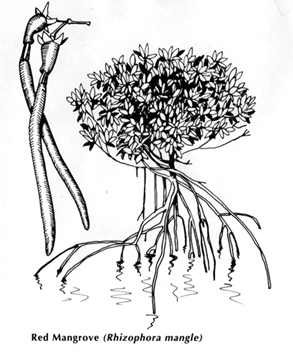 |
|
Sunderban
Area
|
|
|
Sunderban Mangroves: Sunderbans represent a complex estuarine ecosystem dominated by dense forest cover and periodical tidal inundations. They cover an area of about 12000 km2 of which approximately 1/3rd (4200 km2) lies in India and the rest occurs along the Bangladesh coast. The mangrove forest spreads over the alluvial flats of the Gangetic delta, which is intersected from North to South by several wide rivers and sluggish, winding creeks interspersed with lagoons. The entire area is subjected to seawater inundation during the spring high tides while extensive flooding of freshwater occurs during monsoon. The structure and composition of the Sunderbans are maintained by a strong salinity gradient from the freshwater environment of the northeast to the saline environment of the southwest. The natural Sunderban vegetation is composed of halophytic tree species dominated by Rhizophora mucronata, Avicennia marina, Hereteria fomes, Excoecaria agallocha, Ceriops decandra and Sonneratia apetala. The nutrient rich waters of this mangrove area are ideal for fishes and shrimps. There are many brackishwater aquaculture ponds particularly in the northern part of the delta. These impoundments of naturally inundated areas are often several hundred hectares in extent. The rich fishery resources of the Sunderbans is attributed to the fact that mangrove forests serve as links between terrestrial and marine ecosystems, import nutrients from the land via their root systems and export organic matter to the sea in the form of leaf litter. This leaf fall forms the basis of a highly productive and complex food web, which helps make these areas extremely rich and productive. The Sunderbans, which lies at the apex of the funnel shaped Bay of Bengal, receive the full force of intense cyclonic storms occurring at least 4 to 8 times a year between the months of August and November. Due to natural tectonic processes the course of the Ganges, has shifted eastwards, away from the Sunderbans, restricting the inflow of freshwater now during the monsoon period. The volume of silt received by the Sunderbans has considerably declined. This is reflected in the pronounced changes in the floristic composition that have occurred over the past few hundred years. A more severe problem is deforestation, which has reduced to a third in the last two hundred years. |
|
|
Home
Publications New |
||
|
Home
|Institutions | Investigators|
Research | Results
| Management|
|
||
